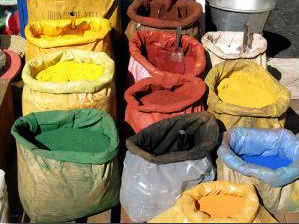
Nuviderm reviews tattoo pigments - a solid waiting for the liquid "carrier"
Have you ever noticed that not one single company that markets a tattoo removal product ever mentions what tattoo pigments are actually composed of ? Could it be that they know their product will not remove these pigments and therefore don’t want to bring up the subject?
Here is something all women can relate to – how the new fingernail polishes, when correctly applied, can last a very long time and require finger nail polish remover (acetone), which is a powerful solvent, to remove the paint pigment? Sure, the finger nail paint may chip or scratch ,but if left alone it would be there for a very long time.
You may have guessed where this is going – the pigments in fingernail polish and tattoo ink are sometimes made of the same thing. Epoxy finger nail polishes are a form of plastic and many tattoo pigments are a plastic base held in liquid suspension for easy injection into the skin. Plastic tattoo pigments have become popular because of their vibrancy under the skin and resistance to fading by sunlight.
Do you think rubbing a tattoo removal cream on your fingernail polish would remove or even dull the finish? Heck no, wouldn’t happen unless the cream had a grit in it and then you are basically slowly sanding the paint off. It would still take quite a while to remove the old paint before you could put on a fresh coat.
The same goes with rubbing tattoo removal cream on your skin to remove tattoo pigment that is deposited BELOW your skin. For the cream to work you must also exfoliate with a gritty cream or use an exfoliation pad or a powered exfoliate of some kind. The exfoliate does the work while the cream may work to fade only your skin pigment – not tattoo pigment.
As I’ve heard said before, you could just skip the cream and simply exfoliate until the tattoo pigment begins to fade and that will take a very long time, longer than Laser,IPL or Nuviderm. As a matter of fact you’ll have several birthdays before you’ve accomplished you goal.
Below is a list of common tattoo pigments, many of the same pigments used in house paint, car paint and yes, fingernail polish. After you read the list ask yourself how a tattoo fade cream could remove iron oxide, cadmium oxide, copper, aluminum silicate, titanium oxide or any of the other minerals and chemicals on the list. Even laser and IPL have a hard time removing the whites, blues and greens, but Nuviderm can remove them all because it is a chemical peel, plus it costs hundreds maybe thousands of dollars less than laser or ipl.
Visit Nuviderm.com for more information.
The Composition of Common Tattoo Pigments
- RED: cadmium red, iron oxide, or napthol. “Iron oxide is also known as common rust. Cadmium pigments are highly toxic. Fewer reactions have been reported with naphthol red than the other pigments.
- BLACK: of iron oxides, carbon. Magnetite crystals, powdered jet and soot. Black pigment is commonly made into India ink. Logwood, found in Central America and the West Indies.”
- GREEN: chromium oxide , Malachite, Ferrocyanides, Ferricyanides, Monoazo pigment, Cu/Al phthalocyanine, or Cu phthalocyanine.
- YELLOW: made of cadmium yellow, ochres, chrome yellow, or disazodiarylide. Reactions are commonly associated with yellow pigments because more pigment is needed to achieve bright color.”
- BROWNS: made of ochre. Ochre is composed of iron oxides mixed and clay. When dehydrated , ochre changes to a reddish color.”
- ORANGE: made of disazodiarylide, disazopyrazolone, or cadmium seleno-sulfide.
- BLUE: cobalt blue, or Cu-phtalocyanine. Blue pigments from minerals include copper carbonate , sodium aluminum silicate, calcium copper silicate and chromium oxides. The safest blues and greens are copper salts. Copper-based pigments are considerably safer or more stable.
- WHITE: lead carbonate, titanium dioxide, barium sulfate, or zinc oxide. Titanium oxides are one of the least reactive white pigments.”
- VIOLET: manganese quinacridone, and various aluminum salts. Dioxazine and carbazole are the most stable purple pigments.”
***
Furl Tags:
tattoo pigment, nuviderm reviews, nuviderm tattoo removal, nuviderm, trust nuviderm, buy nuviderm, tattoo remover, tatoo remover
Del.icio.us Tags:
tattoo pigment, nuviderm reviews, nuviderm tattoo removal, nuviderm, trust nuviderm, buy nuviderm, tattoo remover, tatoo remover
Flickr Tags:
tattoo pigment, nuviderm reviews, nuviderm tattoo removal, nuviderm, trust nuviderm, buy nuviderm, tattoo remover, tatoo remover
Add to: | blinklist | del.cio.us | digg | yahoo! | furl | rawsugar | shadows | netvouz
photocredit:http://www.explainthatstuff.com/paintpigments.jpg